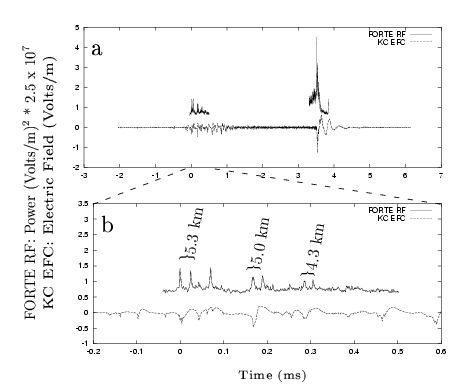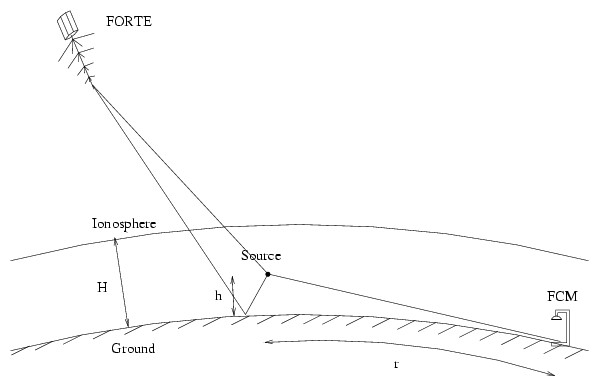Leader Studies with the Los Alamos Sferic Array
LAUR-01-4198
LV/VLF & VHF Lightning Fast Stepped Leaders
This portion of the poster is based on
"LF/VLF and VHF Lightning Fast
Stepped Leader Observations" by Heavner, Smith, Jacobson, and Sheldon,
which has been submitted to JGR.
The July 11, 2000
16:20:39.615019 UT event is presented below. FORTE's 100 MHz
receiver triggered twice during the 8 ms LASA record, collecting
two 546 us records. Panel a is the 8 ms Kennedy Space Center
(KC) waveform overlaid with the two 546 us FORTE RF records.
(scaled by 2.5 x 10 7). The sferic array
located the event ~200 km east of the Florida coast, 309 km
from the KC station. Also shown is an expanded view of the 546 us
plot of FORTE power associated with the leader activity. Three
pulse pairs are identified. Based on the delay between the direct
and reflected pulses, the source heights are 5.3 km, 5.0 km, and
4.3 km as indicated. For time delays of 166.4 us and 119.3
us between the pairs of pulses, vertical velocities of 1.7 x
106 m/s and 5.4 x 106 m/s are determined. For the 285.7
us duration across all three pulse pairs, the average vertical velocity
is 3.2 x 106 m/s.

We have
identified a total of four intense/fast leader events for which
heights and velocities may be determined. These
leaders associated with inital return strokes have average vertical velocity
2.1 x 106 m/s, with a range in velocities of 0.88 - 5.4 x 106
m/s. The leader step altitudes are between 4.0-5.5 km. The
multiple-step velocity determination is consistent with the
velocity required for the leader propagation from the initial
height to the ground in the time between the initial leader and the
return stroke. One important issue regarding these observations is
whether the observed leader is from an initial or subsequent return
stroke (to understand if the leader is a stepped leader or dart
leader), based on evidence discussed by
Heavner et al, 2002, submitted the events are
initial return strokes.
Below, we illustrate the geometry for altitude determination us FORTE. Given
satellite and 2-D source positions, the relative delay provides the
source altitude (Jacobson et al, 1999).

Links to:




